Hey, how’s it going, everyone? Hey, it’s Alex Bazooka here.
After auditing hundreds of local businesses and watching Google’s local algorithm evolve, I can tell you that most local SEO advice is outdated. The businesses dominating local search results aren’t following generic checklists—they’re understanding Google’s actual ranking factors and user intent signals.
Allow me to share the strategies that local businesses are implementing successfully this year.
Google’s Local Ranking Factors: The Real Algorithm Signals
When Google rates local businesses, it looks at three main things: how relevant they are, how far away they are, and how well-known they are. Most SEO guides won’t tell you this, but these things are more or less important depending on the searcher’s situation and the type of query.
You can’t just match keywords to find content that is relevant. Google’s natural language processing has gotten better at understanding what words mean and what people want. When someone types “emergency plumber” into Google, it doesn’t just look for those words. Instead, it looks at which businesses can really resolve plumbing problems quickly based on the services they offer, their availability, and how past customers have used them.
Google’s evaluation criteria include:
- Service offerings that match search intent
- Historical user satisfaction signals
- Business availability and response times
- Semantic keyword relevance
- User engagement patterns
It’s also harder to figure out how far things are. Google now takes into account things like traffic patterns, service area boundaries, and even where the person who searched is most likely to go when ranking results. Google might give a business a higher ranking if it thinks users will be happier with one that is a little farther away.
Why Most Local SEO Services Miss the Mark
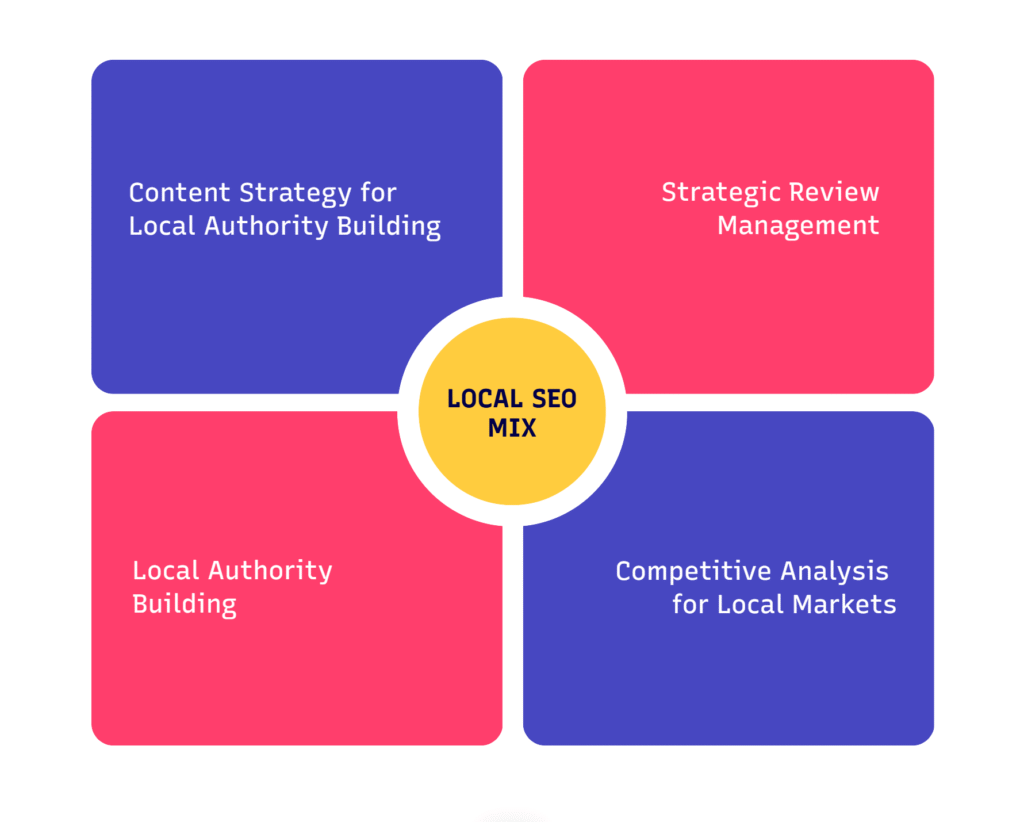
The local SEO busines has a dirty little secret: most agencies are still optimizing for the 2019 algorithm but charging 2025 prices. They focus on strategies that don’t affect rankings anymore and ignore the signals that do.
What Quality Local SEO Actually Requires
To do local SEO well, you need to have a profound understanding of how Google’s E-A-T framework works for local businesses. This means that you should have detailed service pages, get local citations and reviews to show that you know what you’re talking about, and make sure that your NAP data and user experience signals are always the same to build trust.
Essential components of quality local SEO:
- E-A-T optimization for local businesses
- Technical foundation including Core Web Vitals
- Local schema markup implementation
- Mobile-first indexing compliance
- Structured data for business context
- Comprehensive competitive analysis
The technical foundation needs more than just basic on-page optimization. We mean improving Core Web Vitals, adding local schema markup, making sure your site is indexed for mobile first, and using structured data to help Google figure out what your business is all about.
The Budget Reality for Local SEO
When I see local SEO packages priced at $299 per month, I know they’re cutting corners. Quality local optimization requires 15–25 hours of strategic work each month. At that price point, you’re getting maybe 6-8 hours of actual optimization time—barely enough for basic maintenance.
Realistic local SEO investment ranges:
- Basic optimization: $800-1,200/month (small businesses, low competition)
- Competitive markets: $1,500-2,500/month (established competition)
- Multi-location businesses: $2,000-4,000/month (complex optimization needs)
- Enterprise local: $3,000+/month (national chains, high competition)
Instead of trying to do everything badly, I suggest that businesses with smaller budgets focus their resources on activities that will have the biggest effect. It’s better to be really good at optimizing Google Business Profiles and the technical basics than to use a lot of different, ineffective strategies.
High-impact areas for limited budgets:
- Google Business Profile optimization
- Technical SEO foundations
- Local content creation
- Review management
- Citation consistency
Google Business Profile Optimization That Actually Works
Every local business guide tells you to “optimize your Google My Business,” but most miss the strategic elements that actually impact rankings.
Category Selection Strategy
The choice of your main category has a big effect on how visible your local pack is. Pick based on the services that make you the most money, not the ones that offer the most. This choice has a direct impact on your competitive position because Google uses primary categories as ranking signals.
Category optimization best practices:
- Primary category = most profitable service
- Secondary categories support primary focus
- Avoid irrelevant categories that dilute authority
- Monitor competitor category strategies
- Update categories as business focus evolves
Secondary categories should help your main category and also include other searches that are related. Don’t use categories that aren’t relevant to your business. This will make your topical authority weaker. Google’s algorithm can tell when businesses try to cheat the system.
Content Signals That Matter
Google Business Profile posts are more than just ads; they also help your site rank higher. Posting regularly shows that your business is active and gives Google new content to crawl. But the content needs to naturally include relevant local keywords and be useful to users.
Effective GBP content strategy:
- Post frequency: 2-3 times per week minimum
- Content types: Updates, offers, events, products
- Keyword inclusion: Natural integration of local terms
- Call-to-actions: Drive engagement and conversions
- Visual content: Photos and videos for better engagement
Uploading photos shows that a business is active and boosts user engagement metrics. Every week, add three to five new photos that show off your most recent work, your team members, and any changes to your facilities. Google’s image recognition technology gets more business information from these pictures.
Photo optimization checklist:
- Interior and exterior business shots
- Team member photos
- Work-in-progress images
- Completed project showcases
- Product or service demonstrations
- Customer interaction moments
The Q&A section is a ranking opportunity that doesn’t get used enough. Ask questions that include your target keywords ahead of time, and then give full answers. This makes more content available for indexing and makes the user experience better.
Technical SEO Foundations for Local Rankings
Local businesses need to do technical SEO. Google’s Core Web Vitals have a direct effect on local rankings, and businesses with better technical implementations consistently rank higher than competitors with similar authority profiles.
Core Web Vitals Impact on Local Search
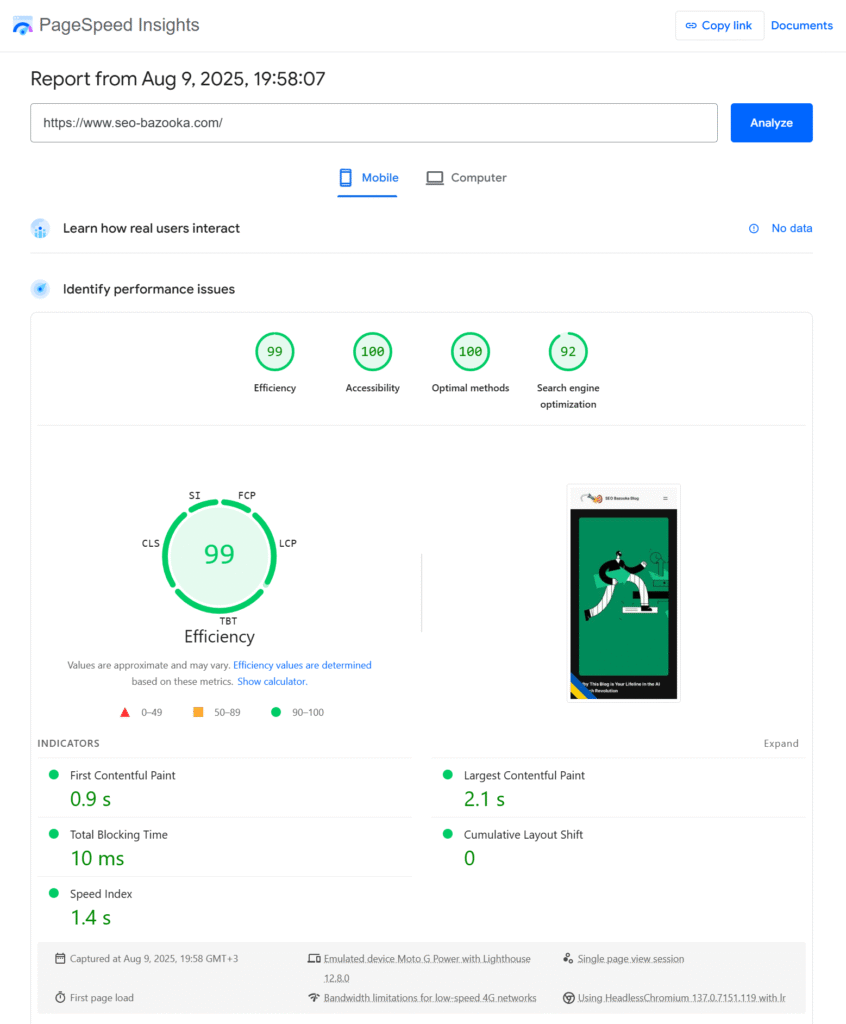
Many people don’t know that page speed has a big impact on local rankings. According to Google, 53% of mobile users leave sites that take more than three seconds to load. For local businesses, this means losing customers and lower rankings right away.
Core Web Vitals benchmarks:
- Largest Contentful Paint (LCP): Under 2.5 seconds
- First Input Delay (FID): Under 100 milliseconds
- Cumulative Layout Shift (CLS): Under 0.1
- First Contentful Paint (FCP): Under 1.8 seconds
- Time to Interactive (TTI): Under 3.8 seconds
Some common technical problems that hurt local rankings are images that aren’t optimized and slow down mobile loading, too many plugins that make pages too heavy, bad hosting that can’t handle traffic spikes, and mobile interfaces that don’t work the same as desktop ones.
Technical issues that hurt local rankings:
- Unoptimized images slowing mobile load times
- Excessive plugins bloating page weight
- Poor hosting unable to handle traffic spikes
- Mobile interfaces inferior to desktop versions
- Missing or incorrect schema markup
- Inconsistent NAP data across pages
Schema Markup for Local Businesses
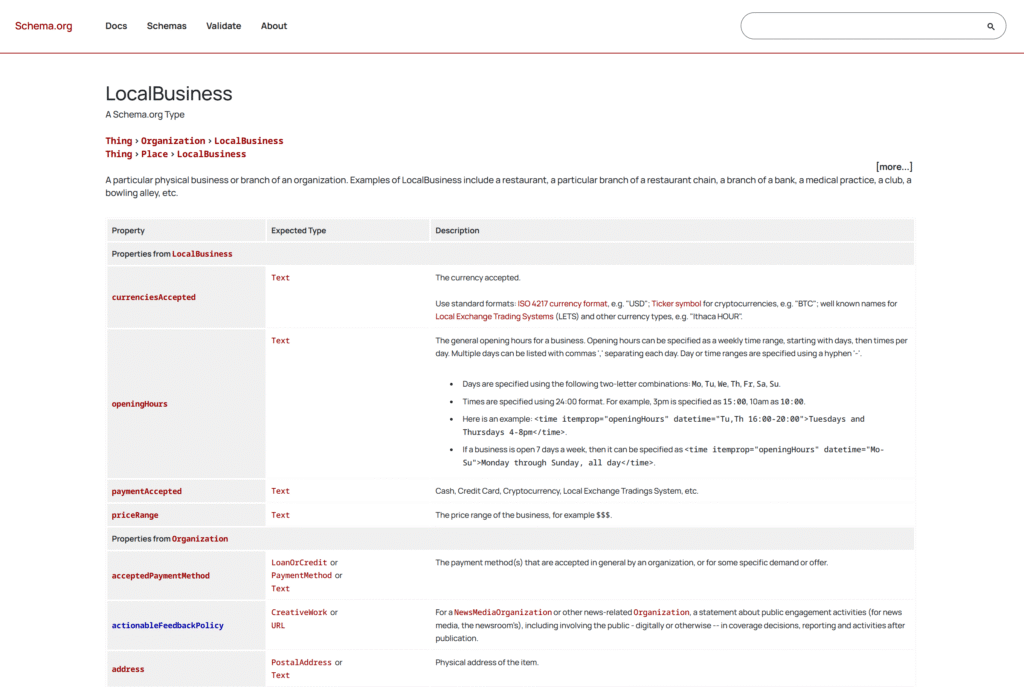
LocalBusiness Schema is just the start. Service Schema for each specific offering, Review Schema to show star ratings in search results, FAQ Schema for common customer questions, and Event Schema for businesses that host local events are all important parts of a good local schema.
Essential schema types for local businesses:
- LocalBusiness: Basic business information
- Service: Individual service offerings
- Review: Customer review display in SERPs
- FAQ: Common customer questions
- Event: Local events and workshops
- Organization: Company structure and branding
The schema markup must be complete and correct. Google’s algorithm can find differences between schema markup and the actual content of a page, which can hurt rankings.
Content Strategy for Local Authority Building
When making content for local businesses, you need to take a different approach than when doing national SEO. You’re not trying to get high rankings for general keywords; you’re trying to become an expert in your field in your area.
Local Service Pages That Convert
Each service page should focus on specific local and service keyword combinations while also giving a lot of information about that service in your area. This means taking into account local laws, prices that are specific to your area, and real-life examples from local customers.
Service page optimization elements:
- Local + service keyword targeting
- Area-specific regulations and requirements
- Local pricing considerations
- Customer case studies with local context
- Service area coverage maps
- Local testimonials and reviews
Generic service pages that could apply to any business in any location won’t rank in today’s local search environment. Google’s algorithm recognizes and rewards content that demonstrates genuine local expertise.
FAQ Content for Voice Search Optimization
Local businesses are starting to care more and more about voice search queries. People ask their devices things like, “Where can I find the best plumber near me?” or “Who can fix my air conditioning today?” Your content needs to directly answer these questions.
Voice search optimization tactics:
- Use natural, conversational language
- Answer complete questions in 40-50 words
- Target “near me” and “who” questions
- Include location-specific information
- Optimize for featured snippet formats
- Structure content for voice assistants
Use language that sounds like how people really talk to organize your FAQ content. Include full answers that could show up in voice search results or featured snippets.
Strategic Review Management
Reviews are more than just social proof; they are also direct ranking signals in local search. When figuring out local rankings, Google looks at how many, how good, how recent, and how different the reviews are.
Review Acquisition Strategy
To get systematic reviews, you need to optimize the process so that happy customers can easily leave reviews. This means asking for reviews at the right time, giving people a choice of platforms, and following up regularly without being pushy.
Review acquisition best practices:
- Timing: Request reviews immediately after positive interactions
- Platform diversity: Google, Facebook, industry-specific sites
- Process simplification: Direct links and clear instructions
- Follow-up sequences: Gentle reminders without pressure
- Incentive compliance: Follow platform guidelines carefully
The goal isn’t to get the most reviews. Instead, it’s to get reviews at a steady pace, which shows that business is still going on. A steady stream of 2–3 reviews per month is often better than short bursts of many reviews.
Review Response Impact on Rankings
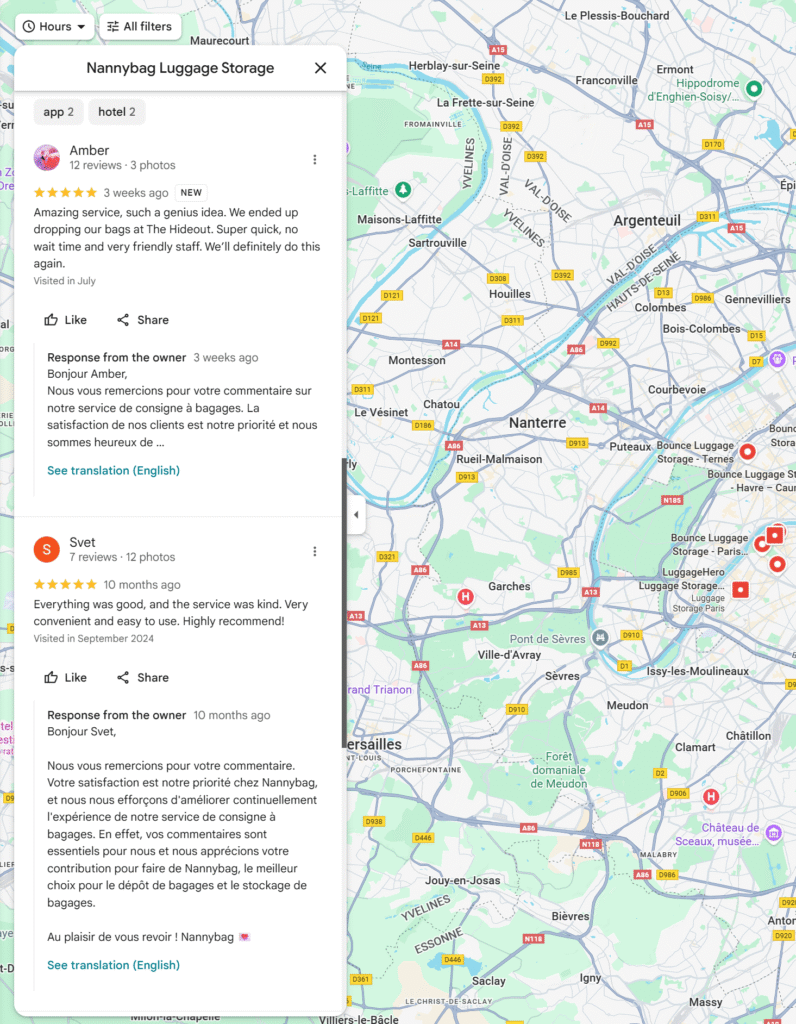
Responding to all reviews—positive and negative—demonstrates active business management and provides additional opportunities to include relevant keywords naturally. But the responses need to be authentic and helpful, not keyword-stuffed templates.
Review response strategy:
- Respond to 100% of reviews within 24-48 hours
- Use natural keyword integration
- Address specific customer concerns
- Maintain professional tone consistently
- Provide helpful information for future customers
- Thank customers for their feedback
Google’s algorithm can tell if reviews are fake or automated by looking at how people respond to them. Real, personalized answers that address specific customer problems are more valuable for ranking.
Competitive Analysis for Local Markets
Local SEO success requires understanding your specific competitive landscape. The strategies that work in one market might fail in another based on competitive dynamics and local search behavior.
Market-Specific Intelligence
Before putting any local SEO strategy into action, look at how your target audience really searches. Some markets use city names to find things, while others use neighborhood names or landmarks. This study should help with choosing keywords and making content.
Local market research essentials:
- Search behavior patterns in your market
- Competitor content and optimization strategies
- Local keyword variations and preferences
- Seasonal search trends and patterns
- Geographic search modifiers used locally
- Voice search query patterns
When doing a competitive analysis, you should look at more than just the rankings. You should also look at how well the other businesses convert and how well they treat their customers. Even if your authority profiles are similar, you can often outrank your competitors by giving users a better experience.
Seasonal and Event-Based Optimization
Local businesses often have seasonal patterns that are easy to predict, which makes it possible to optimize their operations. When the weather gets really hot or really cold, HVAC companies get more searches. Tax preparers get more searches during tax season, and event planners get more searches before wedding season.
Seasonal optimization opportunities:
- HVAC: Summer/winter temperature extremes
- Tax services: January through April filing season
- Landscaping: Spring preparation and fall cleanup
- Event planning: Wedding season and holidays
- Retail: Holiday shopping and back-to-school
- Home services: Spring cleaning and winter prep
Creating content that anticipates these patterns and addresses seasonal needs can capture high-intent searches when competitors aren’t paying attention.
Multi-Location SEO Strategy
To manage SEO for more than one business location, you need to know how Google decides how relevant a location is and stops keyword cannibalization between locations.
Location Page Architecture
Every location page needs to offer something special that is useful to the people who live and work in that area. This is more than just changing the name of the city in a template. You need to know the demographics, service needs, and competition in each area.
Location page requirements:
- Unique, location-specific content
- Local staff information and photos
- Area-specific service considerations
- Community involvement details
- Local customer testimonials
- Geographic service area maps
Content that is specific to a location should include information about local staff, community involvement, service considerations that are specific to that area, and real customer reviews from that location. Google’s algorithm can find location pages that are based on templates and may not rank them well.
Preventing Location Cannibalization
When various websites try to rank for the same keywords, they can hurt each other’s rankings. It’s not about stuffing keywords; it’s about strategically mapping keywords so that the right location pages get the right combinations of geographic and service keywords.
Cannibalization prevention strategies:
- Create unique keyword maps for each location
- Focus on location-specific service variations
- Use strategic internal linking between locations
- Develop location-specific content themes
- Monitor rankings for keyword overlap issues
Internal links between location pages should be planned and natural. They should help the overall structure of the site and help Google figure out how the locations are related.
When Professional Help Makes Sense
You shouldn’t just hire local SEO experts because of the cost; you should also think about the opportunity cost, the pressure from competitors, and the availability of internal resources.
DIY vs Professional Assessment
Small business owners can take care of basic Google Business Profile upkeep, writing simple content, and managing reviews. But technical optimization, schema implementation, and the development of a competitive strategy usually need special knowledge.
Tasks you can handle in-house:
- Google Business Profile updates
- Basic content creation
- Review responses
- Social media posting
- Photo uploads
- Simple citation management
Tasks requiring professional expertise:
- Technical SEO implementation
- Schema markup development
- Competitive strategy development
- Advanced keyword research
- Link-building campaigns
- Multi-location optimization
If local competition is investing heavily in SEO, DIY approaches may not be sufficient to maintain market position. The cost of lost market share often exceeds the investment in professional optimization.
Evaluating SEO Providers
Good local SEO companies know a lot about how your market works and how to make it work for you. They should give you a competitive analysis, the results of a technical audit, and realistic time frame expectations based on how things are right now in the market.
Green flags in SEO providers:
- Market-specific competitive analysis
- Detailed technical audit with priorities
- Realistic timeline expectations (6-12 months)
- Focus on business metrics vs vanity metrics
- Custom strategy based on your market
- Regular reporting with actionable insights
Red flags to avoid:
- Guaranteed #1 rankings promises
- One-size-fits-all packages
- Focus only on keyword rankings
- Lack of technical audit capabilities
- No local market analysis
- Unrealistic timeline promises (30-60 days)
Realistic Timeline Expectations
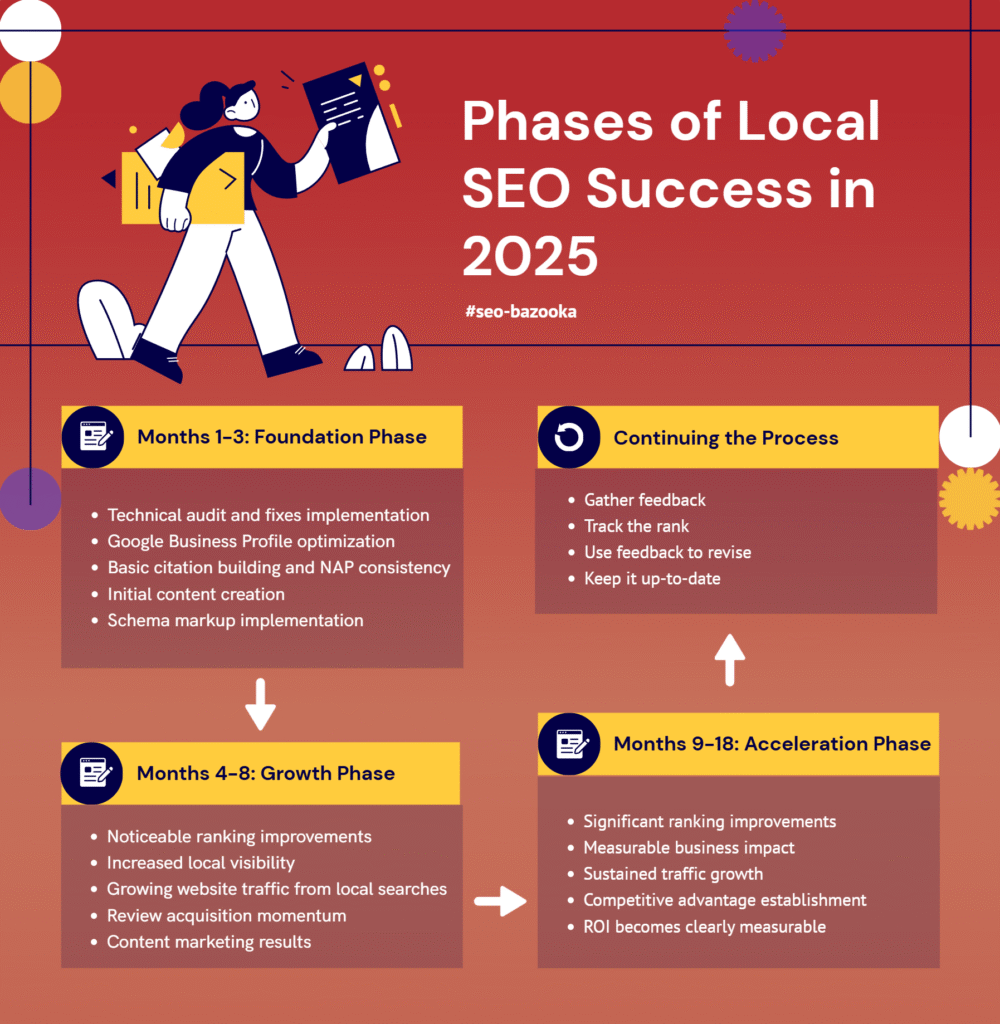
Local SEO results follow predictable patterns, but the timeline varies based on competitive pressure, starting authority, and optimization quality.
Phases of Local SEO Success
The foundation phase (months 1-3) focuses on technical optimization and basic authority building. You might see minor ranking improvements, but significant results require more time.
Local SEO timeline breakdown:
Months 1-3: Foundation Phase
- Technical audit and fixes implementation
- Google Business Profile optimization
- Basic citation building and NAP consistency
- Initial content creation
- Schema markup implementation
Months 4-8: Growth Phase
- Noticeable ranking improvements
- Increased local visibility
- Growing website traffic from local searches
- Review acquisition momentum
- Content marketing results
Months 9-18: Acceleration Phase
- Significant ranking improvements
- Measurable business impact
- Sustained traffic growth
- Competitive advantage establishment
- ROI becomes clearly measurable
Sustained growth (months 9+) happens when authority grows and Google sees that optimization efforts are consistent. Over time, businesses that keep their quality optimization up get more and more money.
Advanced Local SEO Tactics
Sophisticated local SEO goes beyond basic optimization to create sustainable competitive advantages.
Voice Search and AI Optimization
People who use voice search act very differently than those who type in their questions. People use longer, more conversational phrases and want answers right away that they can use. To make your content work better for voice search, it needs to sound like natural speech and answer common questions completely.
Voice search optimization checklist:
- Target conversational, long-tail keywords
- Create content answering “who,” “what,” “where,” “when” questions
- Optimize for featured snippet formats
- Use natural language in content
- Include location-specific information
- Structure FAQ content for voice queries
Optimizing featured snippets can help you show up in voice search results and make your site more visible overall. Organize your content so that it answers specific questions in a clear and concise way.
Local Authority Building
If you want to become a digital authority in local markets, you need to be an expert and get people involved in your community. This includes coverage in local media, chances to speak, being a member of an industry association, and making strategic partnerships with businesses that offer similar services.
Authority-building strategies:
- Local media outreach and coverage
- Industry association participation
- Community event sponsorship
- Speaking at local events
- Strategic business partnerships
- Expert content creation
- Thought leadership positioning
These activities create natural link-building opportunities while establishing the expertise and trustworthiness that Google’s algorithm evaluates.
Budget-Conscious Optimization Strategies
To do effective local SEO on a tight budget, you need to carefully plan how to use your resources so that they are focused on the activities that will have the biggest effect.
High-Impact Priority Areas
Optimizing your Google Business Profile gives you a lot of value for the time you spend on it. If you do this perfectly, it can greatly improve the visibility of your local pack, even if you don’t do a lot of off-site optimization.
Budget-friendly high-impact tactics:
- Google Business Profile mastery (highest ROI)
- Technical SEO foundations (one-time investment)
- Local content creation (ongoing value)
- Review management (consistent effort)
- Citation consistency (foundational requirement)
Investing in technical SEO basics pays off over time. Fixing problems with Core Web Vitals, adding schema markup, and improving the site’s structure all help with other optimization efforts.
Long-term value comes from content that answers real customer questions and shows that you know a lot about the area. Instead of posting a lot of shallow posts, focus on posting useful, in-depth content.
Service Area Business Optimization
Businesses without physical storefronts face unique local SEO challenges but can still achieve strong local visibility through strategic optimization.
Service Area Definition
Google requires clear service area boundaries for businesses without storefronts. Please specify the actual service areas instead of aspirational coverage. Overly broad service areas can dilute local relevance signals.
Service area optimization tips:
- Define realistic service boundaries
- Create specific service area pages
- Address local regulations per area
- Include travel time considerations
- Show service area maps
- Use location-specific testimonials
Create service area pages that provide genuine value for each geographic market. Address local regulations, service considerations, and community involvement specific to each area.
Virtual Authority Building
Even if you’re not there in person, you can build local authority by getting involved in the community, forming partnerships with local businesses, and making real connections with customers. Be active in local business groups, sponsor local events, and stay in touch with other local businesses.
Virtual authority tactics:
- Community event sponsorship
- Local business partnerships
- Chamber of Commerce participation
- Local charity involvement
- Industry networking events
- Online community participation
These activities create natural chances for citations and links, as well as the local connections that Google’s algorithm looks for.
Measuring Local SEO Success
To measure local SEO correctly, you need to look at more than just keyword rankings. You also need to look at metrics that show how it affects your business’s growth and profitability.
Key Performance Indicators
Google Business Profile insights provide valuable data about search visibility, customer actions, and engagement patterns. Monitor how customers find your business and what actions they take.
Essential local SEO metrics:
- Google Business Profile views and actions
- Local organic traffic growth
- “Near me” keyword rankings
- Review acquisition rate
- Citation consistency score
- Local conversion rates
- Phone calls from search
- Direction requests
Website analytics should keep track of local organic traffic, conversion rates, and the path a customer takes from search to purchase. Knowing which optimization efforts lead to real business results helps you use your resources more effectively.
Call tracking and form submissions provide direct measurement of SEO’s impact on lead generation. Many local searches result in immediate phone calls rather than website conversions.
Local SEO in Competitive Markets
To get real results in highly competitive local markets, you need to use smart strategies and be patient.
Competitive Differentiation
Finding underserved niches or areas with less competition is often the key to success in competitive markets. Look for weaknesses in your competitors and gaps in their positioning that you can use to your advantage.
Competitive advantage strategies:
- Find underserved geographic niches
- Target long-tail, specific keywords
- Provide superior user experience
- Focus on specialized services
- Build stronger local relationships
- Create more comprehensive content
A better user experience can make up for any problems with authority. Competitors with stronger domain authority may not be able to outrank businesses that offer better mobile experiences, faster loading times, and more useful content.
Sustained Competitive Advantage
To be successful in the long run, you need to build competitive advantages that your competitors can’t easily copy. This includes better technical implementation, a lot of local content, and real relationships with the community.
Defensible competitive advantages:
- Superior technical implementation
- Comprehensive local content library
- Strong community relationships
- Excellent customer service reputation
- Specialized expertise demonstration
- Consistent optimization execution
Focus on becoming the obvious choice for your target market rather than trying to outrank everyone for every keyword. Dominating specific niches often provides better ROI than competing broadly.
The Future of Local SEO
Listen up. After analyzing this comprehensive piece, I need to give you the unvarnished truth about where local SEO is heading—and it’s not what most agencies are selling you.
The Algorithm Evolution Is Real, and It’s Ruthless
Google’s natural language processing has gotten better at understanding what words mean and what people want. We’re witnessing a fundamental shift from keyword-based ranking to intent-based understanding. The algorithm now evaluates businesses based on their actual ability to solve problems, not just their ability to stuff keywords.
Here’s What’s Actually Happening:
AI-Powered Search Dominance: Google is moving beyond simple proximity and relevance. When someone types “emergency plumber” into Google, it doesn’t just look for those words. Instead, it looks at which businesses can really resolve plumbing problems quickly based on the services they offer, their availability, and how past customers have used them.
Technical Performance as a Ranking Factor: This isn’t optional anymore. Google’s Core Web Vitals have a direct effect on local rankings, and businesses with better technical implementations consistently rank higher than competitors with similar authority profiles.
The E-A-T Reality: Google’s emphasis on expertise, authoritativeness, and trustworthiness for local businesses is intensifying. Generic, templated content is dead. Google’s algorithm recognizes and rewards content that demonstrates genuine local expertise.
Voice Search Integration: People who use voice search act very differently than those who type in their questions. People use longer, more conversational phrases and want answers right away that they can use. This change isn’t a future trend—it’s happening now.
The Brutal Truth About Most Local SEO
Most agencies are still optimizing for the 2019 algorithm but charging 2025 prices. They focus on strategies that don’t affect rankings anymore and ignore the signals that do. If your agency is still pushing basic citation building and generic GMB optimization, you’re getting played.
What Smart Businesses Are Doing Now:
- Hyper-Local Authority Building: Not just community involvement—strategic positioning as the definitive local expert
- Real-Time Business Optimization: Dynamic content that reflects current availability, services, and customer needs
- Visual Search Preparation: Google’s image recognition is becoming a ranking factor
- Zero-Click Optimization: Preparing for a world where answers are served directly in SERPs
Bottom Line Strategic Takeaway:
The best local businesses don’t see SEO as a separate marketing channel; instead, they see it as part of the overall strategy for improving the customer experience.
The future belongs to businesses that understand this isn’t about gaming an algorithm—it’s about becoming genuinely indispensable to your local market. Google’s algorithm is giving more and more points to businesses that show they are knowledgeable, trustworthy, and have authority in their local markets.
Stop chasing tactics. Start building real value. Businesses that treat SEO as customer experience optimization will succeed in 2025 and beyond, as Google’s algorithm specifically rewards this approach.
Is a senior SEO expert with over a decade of experience dominating the digital marketing battlefield. Since 2023, I’ve been riding the AI wave. Since 2024, I have started to work with the SEO Bazooka Blog.

Leave a Reply